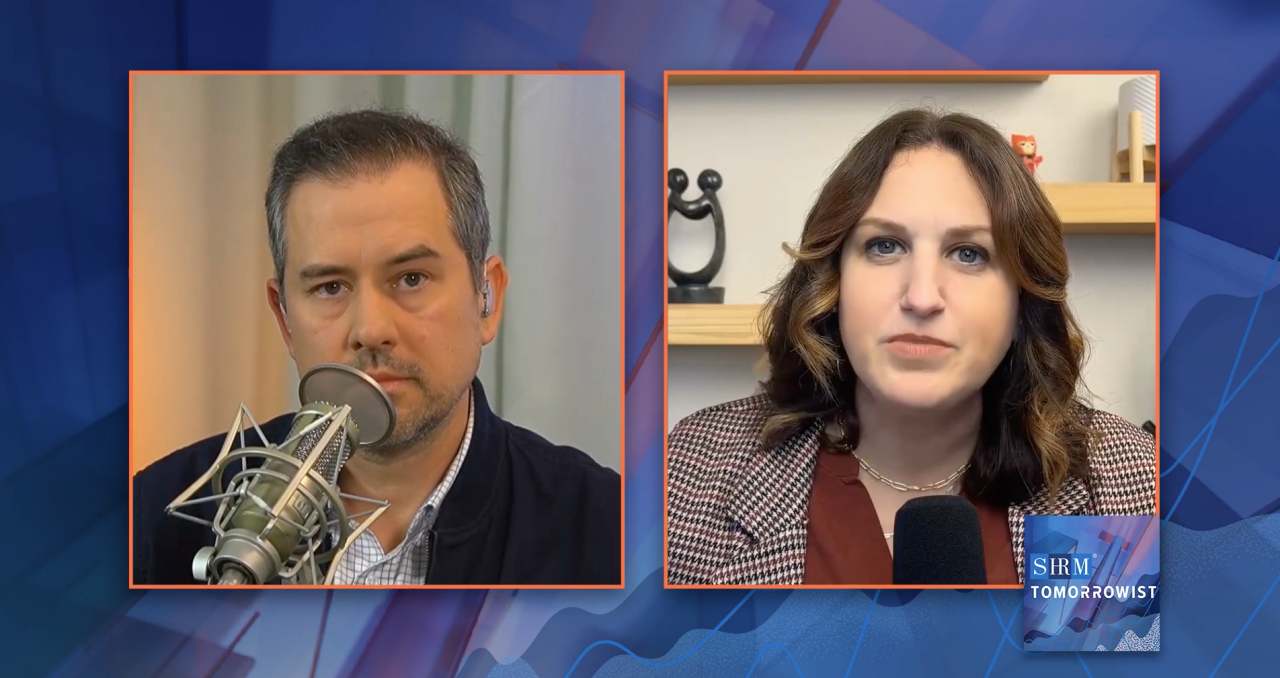Andrea Mata, Ph.D., a clinical child psychologist and founder of BrightSpot Families, recently appeared on SHRM’s Tomorrowist podcast. A summary of that conversation appears below.
Forty percent of high school students report persistent feelings of hopelessness, and 29% struggle with poor mental health. Yet many mental health solutions marketed to executives risk exacerbating these problems, warned clinical child psychologist Andrea Mata, Ph.D., on a recent episode of Tomorrowist. The question remains: Are we coddling future talent, rather than equipping them with the tools they need to navigate workplace mental health challenges?
Mata founded BrightSpot Families to tackle the youth mental health crisis. She cautions leaders of an impending “mental health tsunami,” explaining that today’s youth lack coping mechanisms for workplace conflict and collaboration. “We’re seeing a lot of our teenagers and young adults, those Gen Z-ers, struggling with mental health,” she said. “I don’t think corporate America is ready for this next generation to come into the workplace.”
Mata shared the example of a young professional who took three months off after only two months on the job to recover from a mental health crisis. “I attribute a lot of it to how they’ve been raised, the environments that they’ve been raised in by their parents, and schools that they’ve been in—in the colleges and in the universities.”
The Dangers of “Content Creep”
Executives want to be empathetic, but how do they distinguish between an employee who needs to push through and one struggling with a serious mental health issue? Mata says mental health experts are partially to blame.
Mata delved into the concept of “content creep,” highlighting how the definition of “trauma” has been increasingly broadened over time. She explained that the Diagnostic and Statistical Manual of Mental Disorders (DSM) defines “trauma” in a narrow sense, focusing on life-threatening events or severe harm. However, the term has broadened so much over time that it has created confusion about how to provide effective support. “We’re telling [young people] ‘Hey, you have all this trauma,’ even though it’s not trauma—it’s stressful life events that we’ve taken and now conceptualized as trauma,” said Mata. “We’re telling them that they’re broken.”
Mata believes the push to destigmatize is good, but normalization is not. Normalization leads to workplace confusion and ineffective handling of sensitive mental health issues. Mislabeling on a wide scale blurs the lines between genuine crises and routine challenges—creating dangerous barriers to meaningful, effective support.
Conflict Avoidance and Phone Anxiety
A common behavior emerging from the youth mental health crisis is conflict avoidance, which often manifests as ghosting managers or failing to directly address issues. Mata shared an anecdote about a young worker who quit their job simply by ignoring their manager’s calls. Another emerging behavior of young employees is a reluctance to return phone calls, which stems from limited practice handling interpersonal communication. While these are seemingly small occurrences, these behaviors reflect larger gaps in foundational life skills.
If your younger employees seem to avoid phone calls, you’re not alone. “They’re not having to make phone calls, so much that there’s this woman that refers to herself as [...] The Phone Lady,” Mata said. “I think she charges [...] $450 an hour to teach Millennials and Gen Zs how to use a phone.”
It may seem surprising to Millennial, Generation X, or Baby Boomer executives, but the younger generation lacks experience using phones for actual conversations. They’re more familiar with text-based discussions—and increasingly allow their parents to use the phone for them, Mata explained. “We’re having this generation of helicopter moms,” she said. “They do everything for their kids.”
As a result, this young generation has little to no experience speaking over the phone. “The kids aren’t making appointments. They’re not calling people on the phone,” said Mata. “They’re just moving straight for text—and so they’re getting less practice as a teenager calling.”
Practical Solutions for Executives
Mata outlined actionable strategies to address these challenges: Set high expectations with high support, use 12-week evaluation cycles, start teaching life skills, and retool internal communication.
1. High Expectations and High Support: Young employees should experience challenges but be supported along the way. “They’ve been raised in environments that don’t really set expectations,” said Mata, adding that “they’ve had high support. So we don’t want to take away that high support for them.”
2. 12-Week Evaluation Cycles: Abandoning annual reviews in favor of shorter, goal-oriented cycles creates urgency and accountability. “I would suggest revamping [your] evaluations, moving from yearly evaluations to 12-week goal cycles,” recommended Mata.
3. Teach Life Skills: Essential skills such as phone etiquette, conflict resolution, and financial literacy are increasingly absent among today’s youth. “They should already know these life skills, but the truth of the matter is, they don’t,” said Mata. “I cannot tell you the number of clients that don’t order their own food or drinks at restaurants because their parents still do it for them. I’m talking teenagers and college students.”
4. Retool Communication: Mata also suggested visual storytelling to demonstrate how a team’s contributions are integral to a larger mission. “They don’t want to just be talked at—they want to be involved,” she said. “Allowing more dynamic town halls, where you’re having panels and Q&A’s and discussions and dynamic speakers, and those kinds of things that bring people in and allow you to share.”
From Validation to Action: A Shift to Empowering Young Employees
Finally, Mata warned executives to be wary of solutions labeled “trauma-informed” if they focus solely on validating feelings without addressing actionable behaviors. While destigmatizing mental health issues is essential, Mata argued that an overemphasis on labels like “trauma” can perpetuate a sense of helplessness. Instead, she advocated for empowering employees with skills to more effectively manage challenges and support their mental health.
The “mental health tsunami” is here, but executives can operate productive organizations by balancing empathy with accountability. “ We want to incorporate programming that’s going to coach them [on] how to have life skills, professional skills, personal skills—not ones that are just simply going to validate their feelings,” said Mata. “Feelings are important, but at the end of the day, these are the actions that we need you to be doing for both your best life and for the company’s well-being.”
Was this resource helpful?




